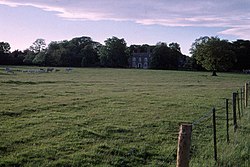Woolsington Hall
| Woolsington Hall | |
|---|---|
 Woolsington Hall (pre-fire) | |
| Location | Woolsington, Newcastle upon Tyne |
| Coordinates | 55°1′55.41″N 1°41′20.68″W / 55.0320583°N 1.6890778°W |
| Built | Third quarter 17th century with late 18th century and early 19th century wings |
| Governing body | Privately owned |
Listed Building – Grade II* | |
| Official name | Woolsington Hall and wall attached to North West |
| Designated | 27 August 1952[1] |
| Reference no. | 1123737 |
Woolsington Hall is a Grade II* listed country house in a 92-acre (37 ha) estate, in the village of Woolsington, in the city of Newcastle, England, north-west of Newcastle city centre, and immediately south of Newcastle Airport. In addition to the hall, the stables, coach house, orangery, walled garden and east wing are Grade II listed.
The hall is not habitable and requires full restoration.[2] It has been on English Heritage's Heritage at Risk Register since 2002.[2]
Design[edit]
The hall is built of stone, with painted ashlar dressings and edged by quoins. The roof is made of slate from the Lake district with stone gables. The house is 2 storeys high, divided into 3 bays and a single bay wing.[1]
History[edit]
Woolsington Hall was the seat of the Bell family, landowners in Dinnington. In 1828 Matthew Bell, MP for Northumberland and Deputy Lieutenant of Northumberland was listed as living at the hall.[3] All four battalions of the 103rd (Tyneside Irish) Brigade camped briefly at Woolsington Hall in May 1915. Conditions were so bad at Woolsington Hall that many soldiers who lived locally went home rather than stay there.[4] The brigade trained in trench fighting at nearby Ponteland, and paraded through Newcastle city centre before departing from Woolsington for Salisbury Plain.[5]
Recent history[edit]
Woolsington Hall was bought by businessman Sir John Hall's Cameron Hall Developments for £1.32 million in 1994. Since 1994, Hall has proposed several developments of the Woolsington site including a football academy for Newcastle United, which was later built in Little Benton. A luxury hotel and golf course was later planned for the Woolsington Hall estate.[2] Hall was threatened with legal action by Newcastle City Council in 2005 unless he carried out repairs to Woolsington Hall.[2]
The hall was put up for sale for £2 million in October 2012, but withdrawn from sale in May 2013. At that time, due to the dereliction of the hall it was described by the Daily Telegraph as a "distressed asset".[6] In 2013 the councillor for the Woolsington ward, George Pattison, said that "It is a complete waste for it to be standing empty. It is a beautiful building and has a lot of historical significance...If it could be restored to something of the calibre of the Mansion House in Jesmond then it would be a great asset to the ward."[2] The house was made weather tight in 2008.[7]
Since 2002 the Woolington Hall estate has been on Historic England's Heritage at Risk Register.[2] The register said that the hall "...is vacant and showing signs of roof failure."[7] It was rated Category C by the register, defined as "Slow decay, no solution agreed".[7] On the night of 30 December 2015, Woolsington Hall was gutted by a fire which destroyed its floors and roof. It was described as an arson attack by Northumbria Police who appealed for information to identify the perpetrators.[8] The Heritage at Risk Register now categorises it as in 'category F, very bad condition'.[9]
The Leazes Gates, a set of two-tonne monumental gates from Newcastle United F.C.'s St James' Park stadium, were stored in the grounds of Woolsington Hall until their restoration in August 2013. It had been hoped that they would form the entrance to a new football training centre at the hall.[10]
References[edit]
- ^ a b Historic England. "Woolsington Hall (1123737)". National Heritage List for England. Retrieved 26 August 2013.
- ^ a b c d e f Liz Walker (27 February 2013). "Sir John Hall's Woolsington Hall back on the market". Evening Chronicle. Retrieved 25 August 2013.
- ^ William Parson; William White (of Sheffield) (1828). History, Directory, and Gazetteer, of the Counties of Durham and Northumberland... W. White & Company. pp. 70–. Retrieved 25 August 2013.
- ^ John Sheen (January 2010). Tyneside Irish. Casemate Publishers. pp. 37–. ISBN 978-1-84884-093-5. Retrieved 25 August 2013.
- ^ John Sheen (January 2010). Tyneside Irish. Casemate Publishers. pp. 42–. ISBN 978-1-84884-093-5. Retrieved 25 August 2013.
- ^ Harriet Dennys (14 May 2013). "City Diary: Sir John Hall's restoration plans for derelict Newcastle asset back in play?". The Daily Telegraph. Retrieved 25 August 2013.
- ^ a b c "Heritage at Risk Register 2012" (PDF). English Heritage. 2012. p. 32. Retrieved 2 August 2013.
- ^ "Woolsington Hall fire: Photos capture moment historic building goes up in flames". The Chronicle. 30 December 2015. Retrieved 25 March 2018.
- ^ "Woolsington Hall, Woolsington - Newcastle upon Tyne". historicengland.org.uk. Retrieved 12 January 2019.
- ^ "Newcastle United wrought iron gates unveiled". BBC News Online. 24 August 2013. Retrieved 25 August 2013.
External links[edit]
- Structures on the Heritage at Risk register
- Houses completed in the 17th century
- Houses completed in the 18th century
- Houses completed in the 19th century
- Grade II listed buildings in Tyne and Wear
- Grade II* listed buildings in Tyne and Wear
- Grade II* listed houses
- Houses in Tyne and Wear
- 2010s fires in the United Kingdom
- 2015 disasters in the United Kingdom
- 2015 fires in Europe

